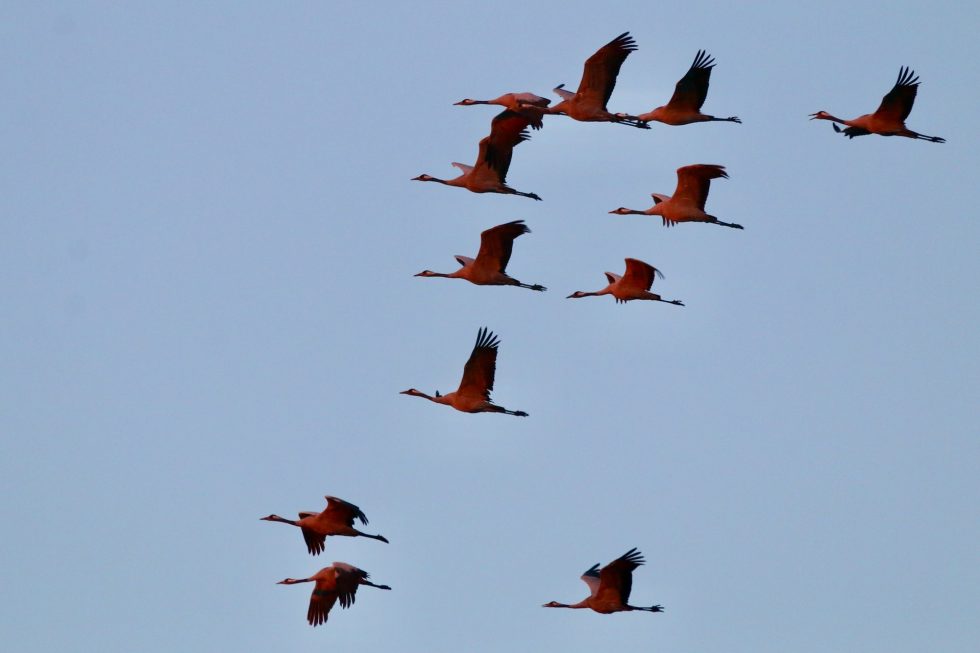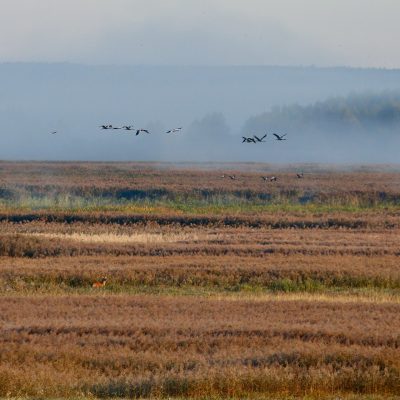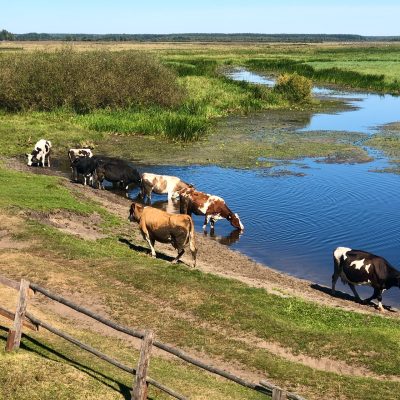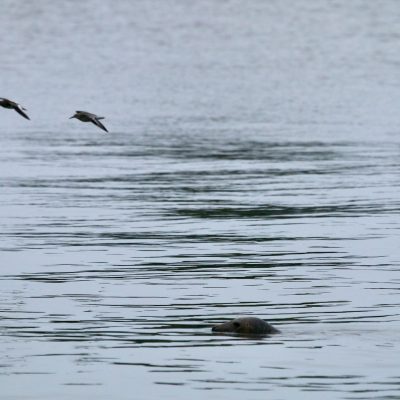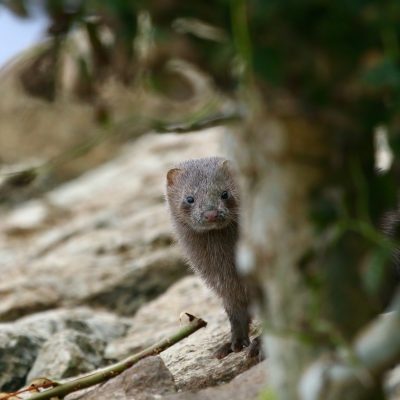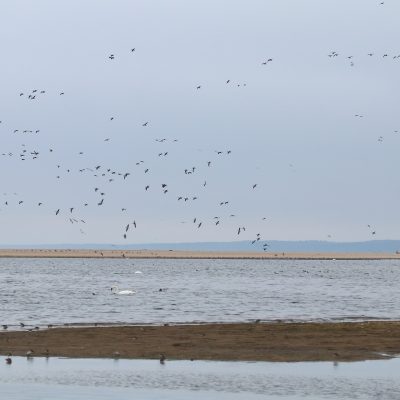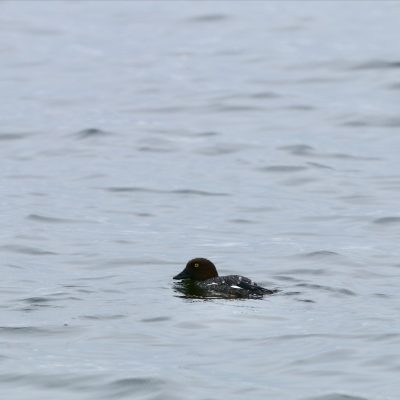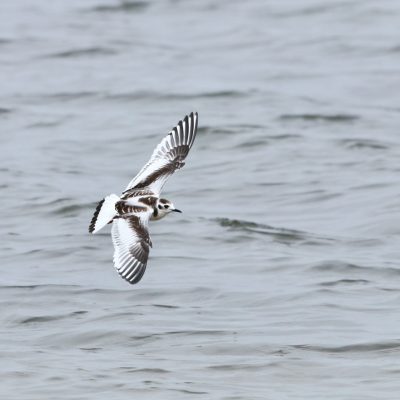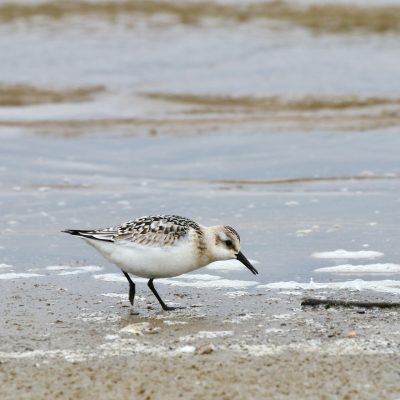Białowieża Forest, Biebrza Marshes & Baltic coast – Sep 2022
Tour Leader: Łukasz Mazurek
Participants: Fiona, Anne, Lesley, Bruce, Martin, Bernard (UK)
Text and photos by Łukasz Mazurek
Day 1
I met Anne at the airport as planned, she had arrived earlier. The plane with the rest of the group was 2,5 hrs late so we waited at a cafe, had a very nice talk, had sandwiches and coffee.
When the main group arrived, the bus picked us up immediately and we were on the way to Bialowieza. Had a quick stop just outside Warszawa at a roadside cafeteria for lunch.
On the way, we have seen numerous Common Buzzards, Harriers, Ravens, a few Roe Deer but no White Storks anymore.
After checking in and a short break we went for a short walk in the forest, Pygmy Owl territory. It was just after sunset and Red Deer were already bellowing. Pygmy Owl responded and a pair came close. Tawny Owl also called. The foliage was dense and it was getting dark. Male and female Pygmys were calling just above our heads but we couldn’t see them. It was an amazing experience and a good start of the tour anyway.
Back at the hotel we had a delicious dinner after which we talked about the history of Poland and details of the itinerary over maps.
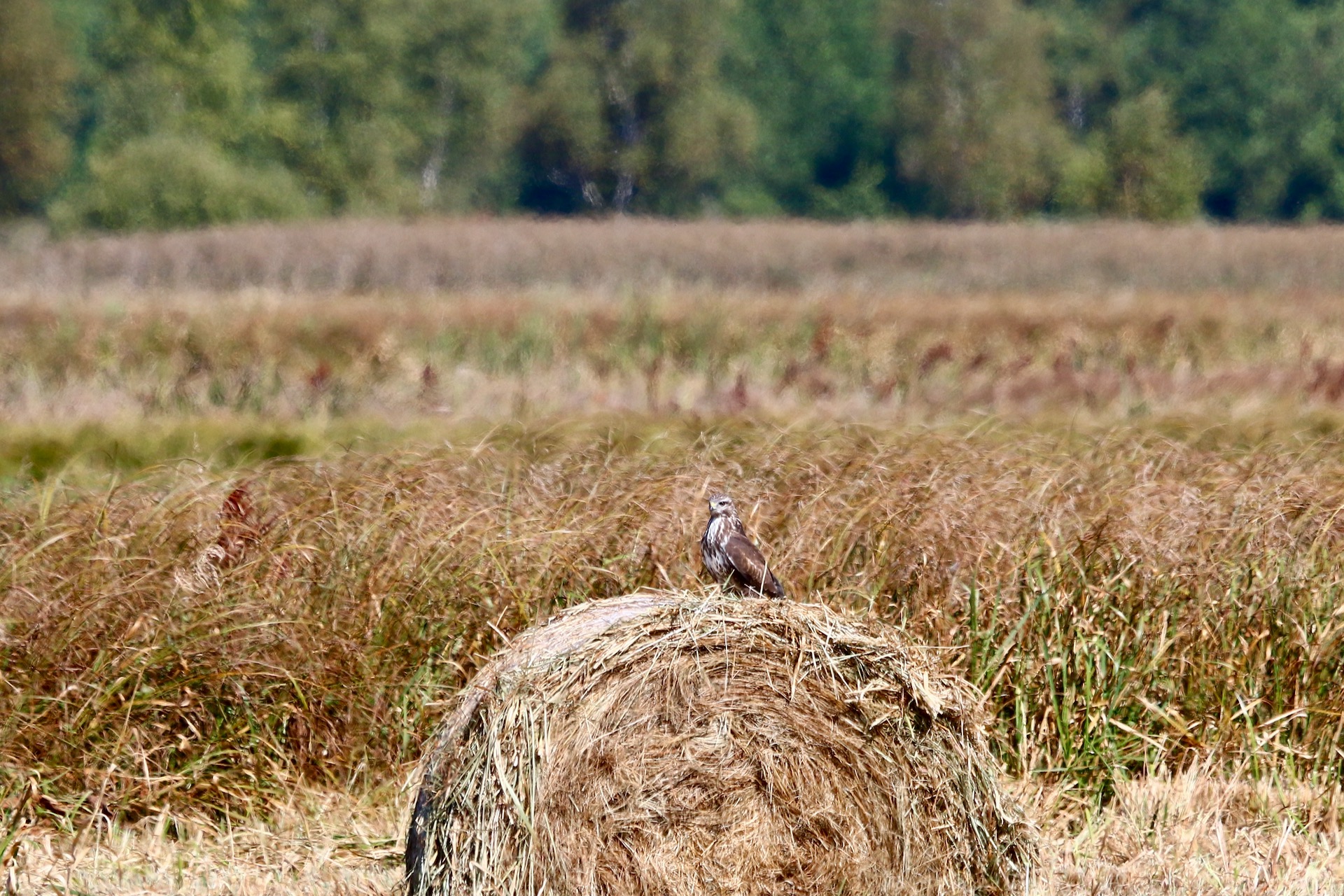
Day 2
We took a one hour walk in the hotel area before breakfast (everyone had a very early start yesterday). It was quiet but we saw a Black Redstart, Marsh Tits, Spotted Flycatchers, heard Hawfinches but couldn’t spot them.
After a hearty breakfast we took a longer walk in one of the best areas for woodpeckers. We started at an area where several huge Oak trees grew together, some of them 300-400 years old. Many centuries old Lime and Hornbeam were there too and one could easily see how many natural cavities there are in their bark, perfect for hole nesting birds. There were many Common Frogs on the forest floor, we also saw a few Common Lizards. Butterflies were represented by Green-veined Whites feeding on Marsh Cranesbill.
We saw a Red Squirrel and had good views of a Grey-headed and Lesser Spotted woodpeckers. A distant eagle appeared a few times through the trees and eventually flew right over our heads and proven to be a Lesser Spotted Eagle. Some time later we saw three Lesser Spotted Eagles, probably a local family with juvenile. To our surprise a Pygmy Owl called in the middle of the day and after a few calls it flew very close and gave us some excellent and long views.
We finished this walk with an amazing lunch of kartacze (local potato dumplings filled with meat) and cold drinks at a local cafeteria. The weather was perfect so we sat outside and enjoyed watching Ravens, Common Buzzards and two more Lesser Spotted Eagles.
After lunch we took a short break back at the hotel. Rested and ready for another walk we took a short drive and met Ewa – our guide for the Strict Protection Area of the Białowieża National Park – the core area of the UNESCO World Heritage Site, one of the last primeval forests in Europe. Ewa, a PhD in life history and ageing of ancient trees, overwhelmed us all with her knowledge and enthusiasm, she kept throwing unbelievable stories and very fresh data of her research. The three hours passed like nothing and although we could feel the several kilometres we have done this day already, it was difficult to get out of the forest.
We have heard several species of woodpeckers in the forest, all quite distant. Saw a huge female of a Tanner Beetle. The best bird this afternoon was probably Great Grey Shrike sat on the wires just outside the Białowieża village.
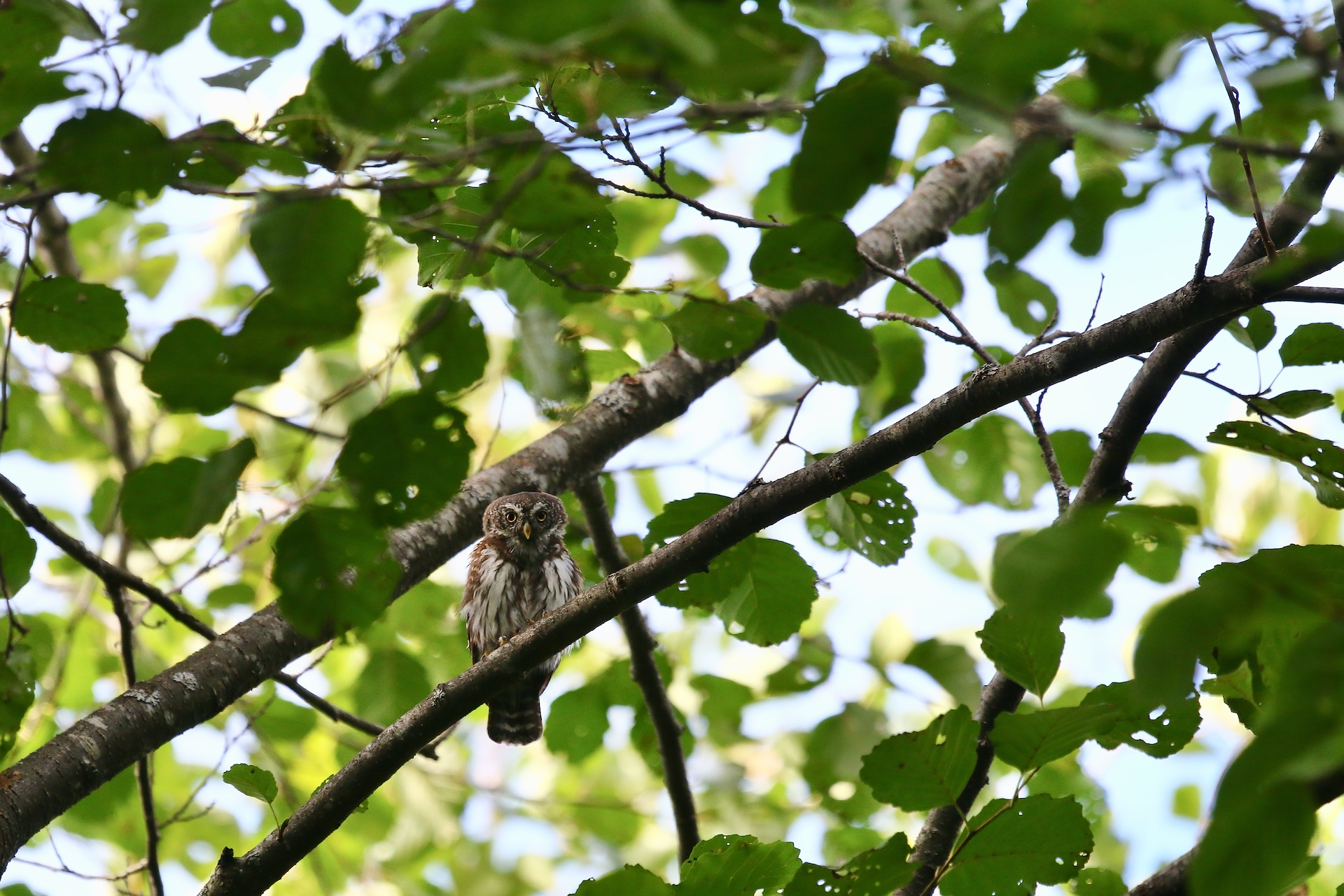
Day 3
Today we decided to start early and go for a Bison Safari at dawn. It was still dark when we met downstairs for a cup of hot, freshly brewed coffee and after about half an hour drive we slowed down and started scanning the forest edge. Within the first few minutes we spotted two Bison bulls so we stopped and watched them grazing for about half an hour from a safe distance until they disappeared back in the woods covered in mist. We continued the drive and saw several Roe Deer, Common Buzzards, Lesser Spotted Eagle and a Red Fox on a lookout atop a hay bale.
After the plentiful, traditional Polish breakfast we went for a short walk near the border with Belarus, a Three-toed Woodpecker and Pygmy Owl habitat. The Owl was very obliging and called very near from a dense spruce stand but the Three-toed Woodpecker was not and did not show at all. We did see, however, several Great Spotted Woodpeckers and Crested Tits.
Back in the village, we still had enough time before lunch and took a walk in the Palace Park – a 19th c. Russian setting around the picturesque ponds. There were many Hawfinches feeding high up in the canopies but once again, we failed to get some decent views. Woodpeckers were more cooperative, though as we had good views of a Lesser and Middle Spotted right next to the path.
We had another fantastic lunch of a local babka ziemniaczana (potato cake with bits of bacon and mushroom sauce) at a lovely Polish restaurant in the Białowieża village.
Some rest was well earned and appreciated by everyone. In the afternoon, we looked for Three-toed Woodpecker at one site but only found a few Great Spotted.
We transferred to another site, this time hoping for White-backed Woodpeckers. After the first few hundred metres we heard several woodpeckers pecking so we started checking what they were and as the first two were Great Spotted, the next two, directly over our heads were White-backed Woodpeckers. They were a bit of a challenge to observe almost vertically up but a few from us managed to get some views. Black Woodpecker also called but did not show up. We have also seen several Nuthatches there.
We continued the walk observing numerous, fresh Wolf territory markings on the way. Red Deer started bellowing and at some point one stag came out right onto the track in front of us. Our goal was a Badger’s sett deep in the woods, apparently also home to a family of Raccoon Dogs this year. We fixed ourselves at a reasonable distance and waited. It wasn’t long when the first Badger, an old adult with a beautiful shiny silver coat came out of the den to check out if it was safe to get out and although the view was obstructed by numerous fallen trees, most of us got some good views.
It was another warm and very atmospheric evening with Red Deer bellowing and Middle Spotted Woodpeckers calling very near us.
After another delicious dinner back at the hotel, part of the group was still eager for a night walk so we took a short drive to the edge of the village and walked into the mist surrounded by roaring Red Deer. The moon was very bright and it was spectacular to hear the deer rut, even more, to observe two huge Bison bulls in the torch light, followed by a stag and a hind of Red Deer. With the moonlight and the moving mist it was an amazing experience.
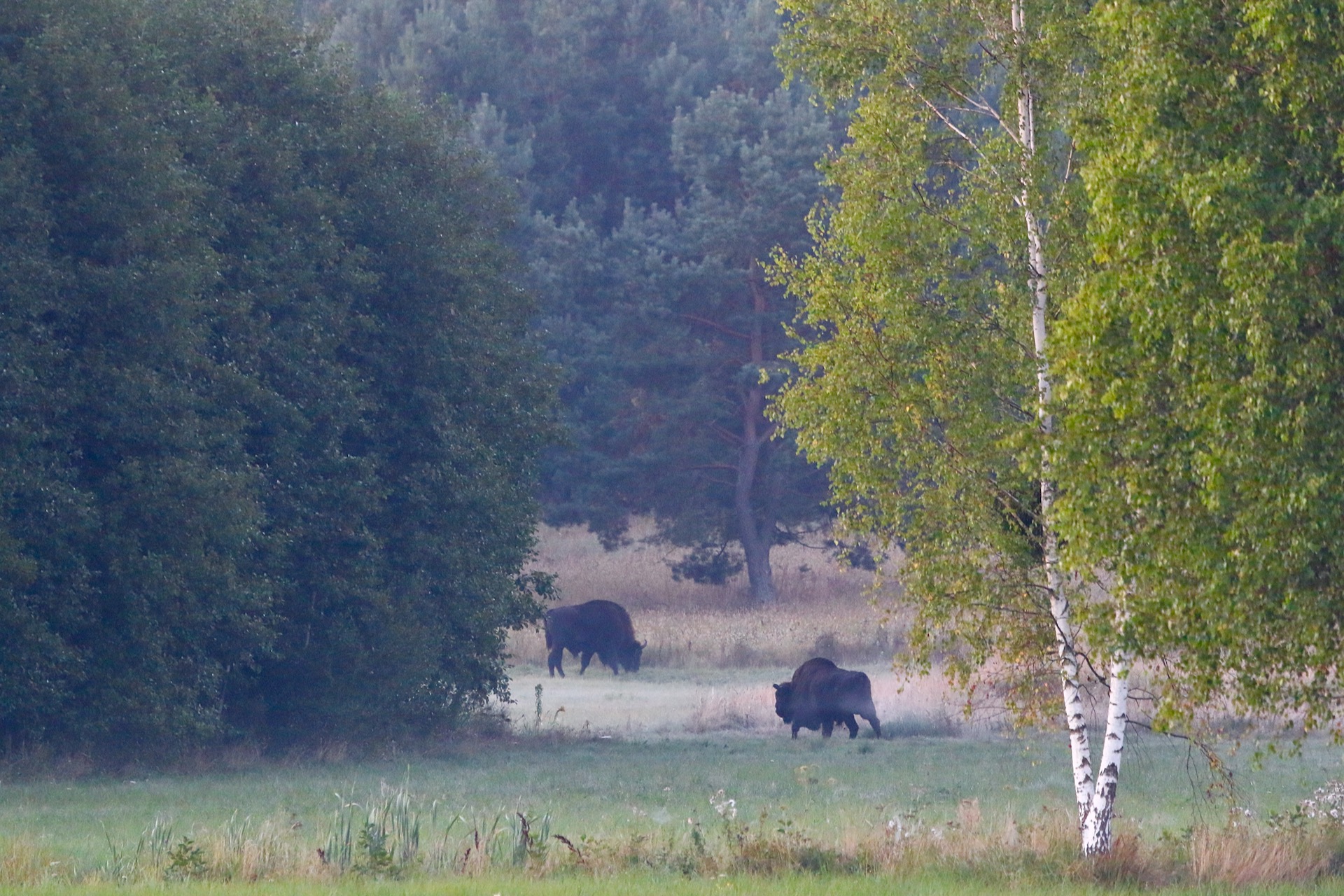
Day 4
After the usual hearty breakfast we packed our bags and were on the way to the Biebrza Marshes. Our first stop was the SE corner of the Siemianówka Reservoir, an excellent site for migratory birds of prey.
We started our observations with a few distant Lesser Spotted Eagles and one possible Greater Spotted Eagle but a bit too far to be 100% sure. Ravens, Marsh Harriers and Great White Egrets were abundant, together with Mallards and Gadwalls. Migrant Hawker dragonflies were still on the wing and they probably attracted a Hobby that flew very low hunting, followed by a juvenile Red-footed Falcon. In the next half an hour, we saw a total of 6 Red-footed Falcons and two Hobbies and all of them showed really well.
We have also had good views of Willow Tits, White Wagtails and Reed Buntings.
Next was a short stop at the dam of the reservoir where we saw a juvenile Penduline Tit, Reed and Willow Warblers, Chiffchaffs, Common Sandpiper, Black-headed and Common Gulls and an interesting Water Knotweed or Amphibious Bistort plant (Persicaria amphibia).
After a huge lunch at a roadside cafe we continued our birdwatching at the Dojlidy fishponds. Some new species for the trip we saw there included Little and Black-necked Grebes, Great Crested Grebes, one juvenile Red-necked Grebe plus Shovelers.
We reached our hotel in the Biebrza National Park on time for a delicious dinner and continued in the minibus afterwards. It was dark by then and we aimed at finding Beavers swimming in the river. This trip started with fantastic sightings of a Tawny Owl flying in front of the minibus and sitting in the trees, followed by a Red Fox and a Raccoon Dog in car lights. When we reached the river, it was very foggy and we could hardly see the other shore several metres away. Nevertheless we stayed put, had excellent scope views of a Moon as well as Jupiter with its four moons visible in one line and hoped for the fog to disperse and Beavers to start swimming. After about half an hour I saw a suspicious shape on the opposite bank emerging from the mist. It was a Beaver that came out to feed. We watched it feeding and swimming for quite some time when the fog diminished.
Tired and happy we hit the road back, watching two Red Foxes in car lights on the way back.
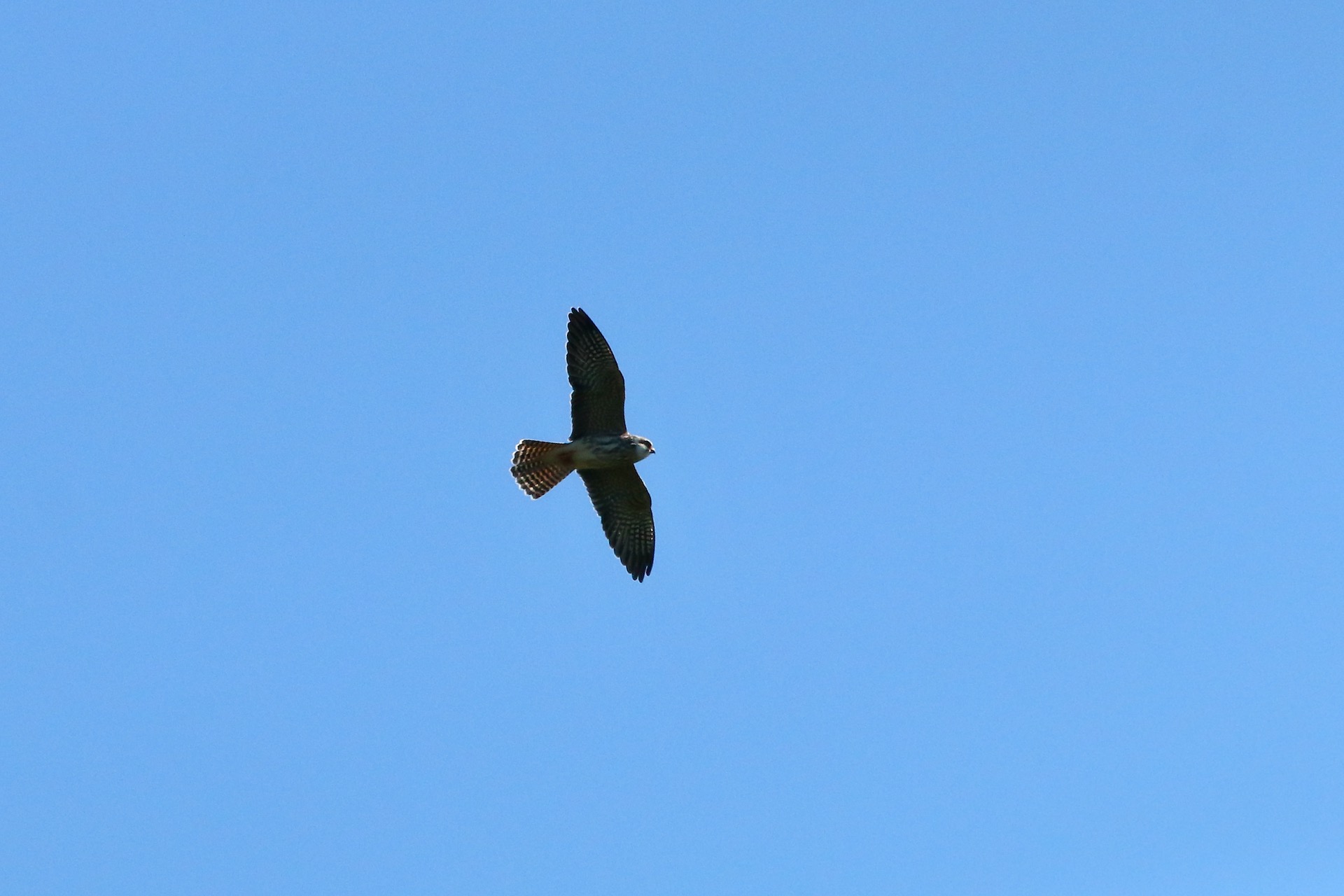
Day 5
It was high time for another dawn patrol and we took this opportunity to take a walk in the Elk (Moose) habitat. The bus dropped us off at the edge of the forest and we went into the marsh still before sunrise. The fog was not too bad and soon we spotted the first Elk, a huge bull with amazing antlers but he disappeared in the shrub and the fog quickly, before everyone managed to get good views of it.
The sun was just about to rise when the Cranes woke up and started flying out of the marsh into the fields outside the Park where they feed during daytime. It was fantastic to see and hear them flying so low right over our heads with the sun rising behind us. We continued our walk and have soon spotted a female Elk with a calf nearby. They gave us much better views, together with flocks of Cranes just over them. Another cow of Elk in the mist a bit further down the trail was very shy and hiding behind the bushes. When we came up the observation tower the fog has almost dispersed and we spotted a female Red Deer. The sky was still full of Cranes. We decided to continue exploring this area and our last sighting of this morning was another bull of Elk, this time much closer and better view – a very satisfying finish of a very successful and atmospheric morning.
After breakfast and a bit of a break to give everyone some rest we went on a drive around several sites in the National Park. Saw beautiful, vast, stunning natural landscapes, many Marsh Harriers, Common Buzzards, Cranes, Great White Egrets, wildfowl, Lapwings and Common Snipe, another bull of Elk quite near, a few Roe Deer, Red Fox, numerous domestic cows grazing in the marsh. A quick search for a White-backed Woodpecker produced one individual drumming in the distance but not seen. An unexpected sighting was a flock of 8 Grey Partridges unintentionally spooked by Martin as well as the only Red-backed Shrike and the only Wheatear of the tour.
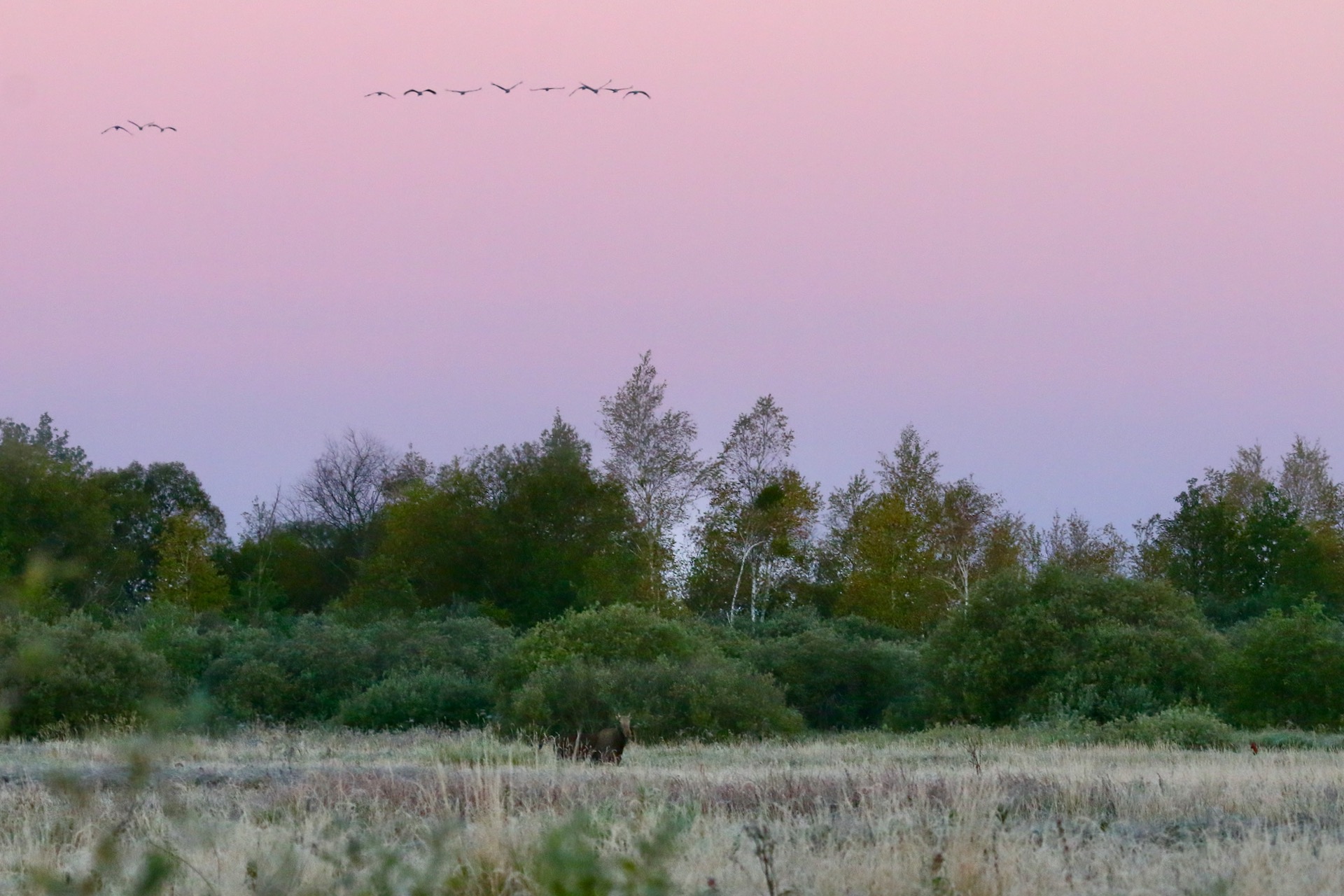
Day 6
Today we were about to leave the Biebrza Marshes after breakfast so I offered our last short trip there – just one hour before breakfast to catch up with the wildlife of our hotel surroundings.
Red Deer were bellowing really close when we went out. We started off with a flock of Treesparrows, Goldcrests, many Jays, Cranes and Buzzards flying over. A Black Redstart showed very well. We also had good views of a Black Woodpecker responding very well to my whistle and showing nicely in flight and perched up a dead tree. We finished the walk with a Middle Spotted Woodpecker just in the hotel’s garden.
After breakfast we hit the road towards the Baltic coast. Seen some Common Buzzards, Marsh Harriers and a Red Kite on the way. We stopped for lunch at a small Polish restaurant near the Łuknajno Lake – a place famous for hundreds of swans and other waterfowl safely moulting there in the shallow waters and vast reedbeds all along the shores. A short walk and a view from up the tower there produced a few Marsh Harriers, 200+ Greylag Geese, Black Cormorants, 100+ Great White Egrets, 500+ Mute Swans, Gadwalls, Wigeons and 200+ Great Crested Grebes.
We arrived at our hotel on the Wisła spit on time to take an evening walk in the area. We decided to hit it up to the Baltic coast and it was a good decision as we quickly came across a huge adult of a White-tailed Eagle right over our heads. It was probably looking for a safe place to roost as we approached. We walked a short loop along the beach and back to the hotel through the forest, the town and along the lagoon, seen some Black-headed, Common, Herring and Caspian Gulls. The last bird this day was another White-tailed Eagle circling over the lagoon. We could now have dinner and rest.
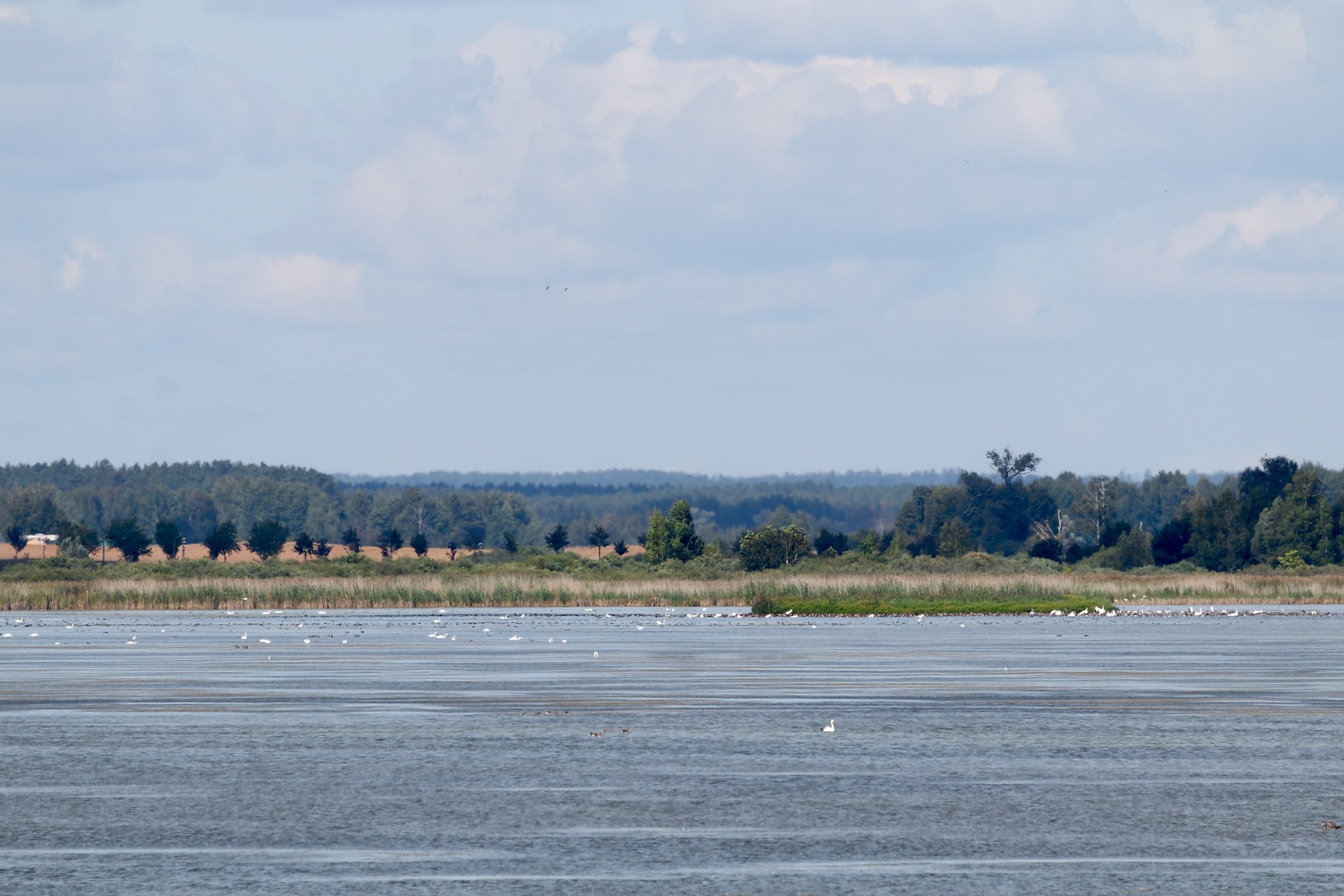
Day 7
It started to rain and the forecast showed rainfall until midday and a sunny afternoon so we decided to start with city sightseeing as seeing Gdańsk was important to all members of the group. After a short walk into the old town of Gdańsk, visiting a tourist info point to get maps and guidebooks I pointed all the basic directions to major points of interest and everyone had a few hours for self exploration of the city.
Full of good impressions, so different from the last few days spent in the wild we met again after lunch and had a short drive to the Ptasi Raj reserve covering a couple of lagoon lakes, a reedbed and banks of one of the Wisła River mouths.
It was still cold, windy and misty but slowly getting better and we spent a few good hours there visiting the best vantage points. We saw plenty of wildfowl today. Some new species for the trip or good sightings included Shovelers, Pintails, Wigeons, Teals, numerous Pochards, Tufted Ducks, Goldeneye, Goosanders, Little Grebes, Crested Tits, Penduline Tit. We have also heard Bearded Reedlings a few times but didn’t manage to spot them.
We took a ferry across Wisła River on our way home for dinner and waiting for it to depart we took a while to scan and count the birds seen in the Wisła mouth. Apart form the common waterfowl we spotted an adult White-tailed Eagle but best of all were thousands of swallows and martins migrating and feeding low over the water. A double counting/estimation of the numbers resulted in about 20 thousand Barn Swallows and Sand Martins together!
The last sighting today just before we reached our hotel was a single Wild Boar running through the village, seen from our minibus.

Day 8
We met down at our hotel buffet breakfast, an unbelievable choice of cold and hot foods. The chef had learned he had Britts on board by that time and even prepared a special place for us with a set of hot, full english breakfast to add to the usual variety!
Today we went for a full day trip in the main mouth of Wisła River, a renowned nature reserve protecting Sandwich, Common and Little Terns breeding habitat as well as important areas for migratory waders and Grey Seals.
We started our walk along the river in the village watching a Sparrowhawk, Goldeneyes, Goosanders and Common Terns. Common Sandpipers, Redshanks and Mallards were numerous along the banks. We also saw an impressive Pine Hawk Moth caterpillar on the path.
The closer we got to the sea the more birds we saw: Every step there were more of everything we had already seen plus Little Gulls, Tufted Ducks, Herring and Greater Black-backed Gulls, Greenshanks, one Spotted Redshank. We have even seen two Swifts, quite late as for Poland.
Suddenly the waders flew away and we spotted an American Mink running along the bank. It gave us fantastic views and photography opportunity for a long time. Next was a Grey Seal swimming in the river, obviously interested in what we were doing here. It came close to us a few times as we walked along the bank.
When we reached the Baltic coast the real birdwatching started. Flocks of waders feeding near were mostly Dunlin, Ringed Plovers and Little Stints but a detailed look produced numerous Sanderlings, 7 Curlew Sandpipers and 3 Red-necked Phalaropes among them. Redshanks, Knots and Bar-tailed Godwits also came about a few times.
Waterfowl included some 1200+ Greylag Geese, a few dozen Goosanders, Goldeneyes, Tufted Ducks, Gadwalls, Black Cormorants. Distant islands were occupied by dozens of Cormorants and some 200 Grey Seals. Small groups of Little Gulls, Common and Sandwich Terns flew by from time to time and we managed to spot one Arctic Tern and a few Black Terns among them. Some Goosanders and Goldeneyes were feeding near thus allowing for great views and photos.
We had our packed lunch on the bank of the river and started the walk along the shore. After a few hours birdwatching there we have just thought we saw pretty much all that there was to see when a White-tailed Eagle flew by and sat on a distant sandy spit with a blessing – caused ALL the birds to go up in the air, fly around and sit back after a while. We had a chance to scan through all the flocks again and added several more new species to our list: Ruff, Avocet, Wood Sandpiper, Grey Plovers and a few more Red-necked Phalaropes.
Our last stop this day was a walk up to a viewing tower on the Wisła spit, a site known for good views of migratory birds of prey. The weather was not perfect and the winds were still southern so we didn’t see much bird activity from there but a migration of swallows was obvious, several Ravens, Grey Herons and Black Cormorants also flew by, Great Spotted Woodpecker, Blackcap and a White-tailed Eagle called.
It was an excellent birdwatching day concluding our tour we decided to celebrate with a few different kinds of Polish vodkas to taste, yet, we still decided to go out after dark looking for Wild Boar. It was Saturday evening and several parties were going on in the town, many people in the streets so we decided to try our luck in the forest. It was very atmospheric and we didn’t see Boar in the end but found a huge Blue Underwing Moth that was the size of a human hand.
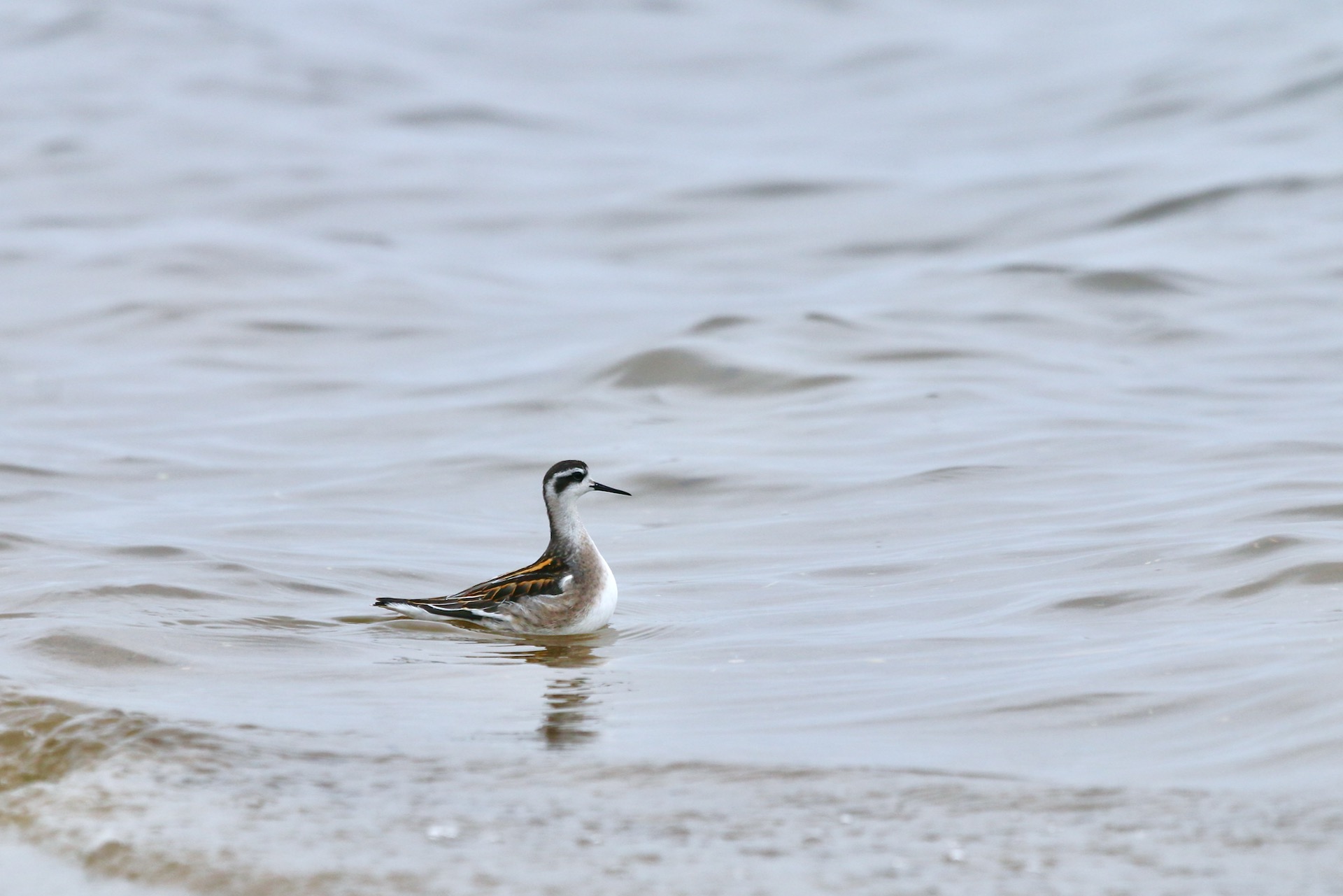
Day 9
We packed our bags early today and left just after breakfast, just to make sure we manage to get to Warszawa on time. It was a smart decision as traffic was low on a Sunday morning and with a couple of coffee stops and several Cranes, Buzzards, Lapwing and Starling flocks later we reached Warszawa on time for lunch. I managed to book us a table at a small Polish-Jewish restaurant in the Old Town. It was a nice finish of the tour and we even had the time to take 1 hour walk around Warszawa Old Town before getting back to the minibus that drove us to the airport.

